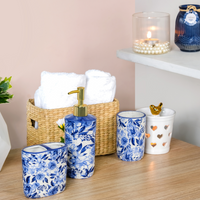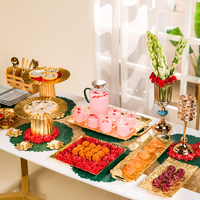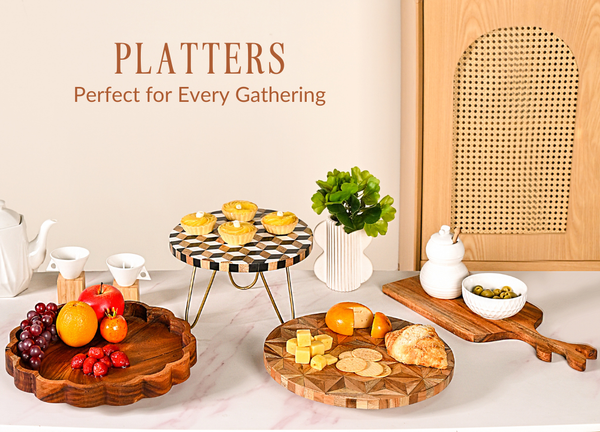Brass is the festival’s everyday gold: affordable, audible, and household-ready.
In the vibrant tapestry of Indian festivals, few materials hold as much significance as brass. More than just a simple metal, it's a profound thread that weaves together the spirituality, tradition, and culture of the country. A festival's story isn't just told in light and colour; it's heard in the resonant chime of a bell and felt in the weight of a lamp. At the heart of this experience, you'll almost always find brass.
Its warm, golden sheen isn't a mere imitation of gold; it's a promise of prosperity and an auspicious welcome. For centuries, brass has been a cornerstone of our rituals, turning everyday utensils into sacred objects and simple home decor into vibrant artifacts. This blog explores why brass is a timeless vessel of faith and a living part of our heritage, forever linking our past to our present.
A Brief History of Brass in India
The story of brass in India is as old as its first use. While pure copper has a long history in the subcontinent, brass, a versatile alloy of copper and zinc, emerged later, likely through trade with regions that had mastered zinc smelting.
The earliest known examples of brass artifacts in India date back to the Indus Valley Civilization, but its widespread use in religious and domestic contexts began to flourish during the Mauryan and Gupta periods. Artisans discovered that this alloy was stronger, more durable, and easier to cast than pure copper, making it ideal for creating intricate designs for pooja items and everyday dining utensils, including a complete dinner set.
The material's golden luster and resistance to corrosion made it a favored alternative to gold, which was often too costly for the general populace. This democratized its use, allowing brass to become a staple in homes across all social strata.
Over centuries, various regions developed their own unique brass traditions and craftsmanship, from the elaborate idols of South India to the ceremonial lamps and vessels of the North. This rich history has cemented brass's place not just as a metal, but as a vital part of India's cultural and spiritual heritage, carrying forward stories of generations in its polished sheen.
Brass in Festive Rituals
Brass Diyas and Lamps
The festival of lights finds its soul in the glow of a brass diya. Lighting a brass oil lamp is a fundamental ritual that signifies the triumph of light over darkness and knowledge over ignorance. These small but powerful objects are central to Diwali and other celebrations, symbolizing continuity and the promise of prosperity. A multi-tiered brass diya stand or a collection of simple brass diyas creates a mesmerizing and sacred atmosphere.
Temple Bells and Ghantas
The resonant sound of a brass bell, or ghanta, is a quintessential element of Indian festivals and puja. The chime is believed to purify the environment, call upon the deities, and focus the mind for devotion. The sound itself is a form of prayer, a vibration that connects the physical and spiritual worlds. When worshippers enter a temple, they ring the temple bell as a sign of respect and to announce their presence to the divine. This tradition extends to homes, where small brass bells are part of the daily puja setup, their sound bringing harmony and serenity to the sacred space and to the hearts of those who hear it. 
Pooja Thalis and Utensils
At the heart of any puja is the brass pooja thali. This gleaming plate is meticulously arranged with all the necessary items for worship, from flowers and incense to rice and sindoor. Brass is considered a satvik, or pure, material in Ayurveda, making it ideal for sacred use. All the accompanying pooja items, such as a brass kalash for holy water and small katoris for offerings, are chosen for their purity and durability. The daily ritual of polishing and caring for these brass utensils is itself an act of devotion.
Idols and Decorative Items
Beyond their role in rituals, brass objects also serve as profound symbols of faith and artistry. Exquisite brass god idols like a detailed brass Ganesha idol or a graceful brass Lakshmi idol are often the centerpieces of festival altars. These sacred statues are not just representations of deities; they are believed to be the embodiment of divine energy. Over time, they become cherished family heirlooms, passed down through generations. Additionally, brass is widely used for brass decorative items and thoughtful brass gift items that carry the essence of tradition.
Symbolism of Brass
Beyond its physical properties, brass holds a deep well of symbolic meaning in Indian culture.
-
Symbol of Prosperity and Auspiciousness: Brass's golden sheen instantly connects it with wealth, prosperity, and good fortune. While it offers the regal elegance of gold, its affordability has made it the "everyday gold" of Indian culture.
-
Represents Purity and Positive Energy: According to ancient Ayurvedic traditions, brass is considered a satvik or pure material. This belief associates the metal with positive and harmonious energy. It's why brass is the preferred metal for vessels and utensils used in both religious rituals and for storing water.
-
Encourages Inclusivity of Worship: The widespread availability of brass has democratized spiritual practice. While precious metals like gold are rare and expensive, brass allows for an inclusivity of worship that is accessible to all.

The Science of Brass in Rituals
The widespread use of brass in rituals isn't just about tradition; it’s also rooted in its unique scientific properties. The acoustic resonance of this copper-zinc alloy creates the clear, vibrant sound of temple bells and gongs, a sound believed to purify the air and call upon the divine.
Its durability and malleability allow artisans to craft intricate and lasting ritual objects, from detailed idols to ornate pooja thalis. In addition to these physical properties, ancient Ayurvedic beliefs hold that brass has antibacterial qualities. This is why water stored in brass vessels is considered beneficial for health, adding a layer of scientific and spiritual purpose to its sacred use.
Regional Variations in Brass Traditions
The use of brass showcases the diverse artistic traditions across India, with each region developing its own unique style and purpose for the metal.
East India: In states like West Bengal, brass bells and ceremonial puja plates are an integral part of festivals like Durga Puja, where they are used to adorn the sacred space and ring in devotion.
West India: In Maharashtra and Gujarat, the tradition of polishing heirloom brass lamps and utensils before Diwali is a deeply cherished ritual, linking generations through a shared act of reverence and preparation for the festival of lights.
North India: This region is known for its ornate and heavily decorated brassware. In states like Uttar Pradesh and Punjab, brass is crafted into elaborate statues and utensils, and the tradition of using temple bells for puja remains a strong part of the culture.
South India: This region is famous for its large, ornate brass urlis, which are filled with water and flowers for home decor. Tall, elaborate oil lamps and beautifully crafted idols are also a signature of South Indian craftsmanship. 
Contemporary Role of Brass
Today, brass is experiencing a vibrant revival, moving from purely ritualistic use into the world of modern decor and sustainable living. It's also being re-imagined as stylish and sustainable cookware, perfect for the contemporary kitchen. Designers and artisans are reinterpreting traditional brass items, creating elegant candle holders and other home decor pieces that blend seamlessly with contemporary aesthetics.
Brass is being celebrated as a sustainable choice, a durable and endlessly recyclable alternative to single-use materials. As people seek items that tell a story and carry a sense of heritage, modern brass artifacts are becoming popular choices for gifting. They offer a beautiful way to carry forward tradition with a modern twist, ensuring this rich legacy continues to shine for generations to come. 
In a world of constant change, brass remains a constant, its enduring presence in our festivals a testament to its cultural and spiritual significance. We have journeyed through its rich history, explored its use in sacred rituals, and understood its deep symbolism as a metal of purity and prosperity. From the resonant chime of a temple bell to the tranquil glow of an heirloom brass oil lamp, these objects are more than mere artifacts; they are conduits of positive energy and vessels of cherished tradition.
The act of polishing a brass item before a festival is a ritual in itself, a way of connecting with our ancestors and preparing for a new season of joy. Ultimately, brass is an eternal part of our celebrations, forever linking our past to our present.





















